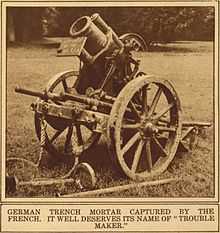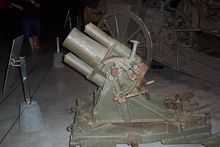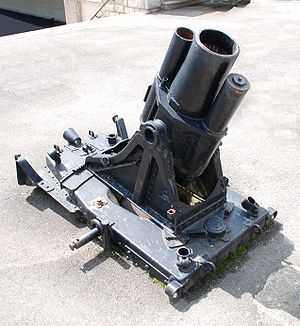17 cm mittlerer Minenwerfer
| 17 cm mittlerer Minenwerfer | |
|---|---|
|
| |
| Type | Medium trench mortar |
| Place of origin | German Empire |
| Service history | |
| In service | 1913–1918 |
| Used by | German Empire |
| Wars | World War I |
| Production history | |
| Designer | Rheinmetall |
| Manufacturer | Rheinmetall |
| Produced | 1913–18 |
| Number built | approx. 2361 |
| Variants | 17 cm mMW n/A |
| Specifications | |
| Weight | 483 kg (1,065 lbs) |
| Barrel length |
a/A: 64.6 cm (2 ft 1 in) L/3.8 n/A: 76.5 cm (2 ft 6 in) L/4.5 |
|
| |
| Caliber | 170 mm (6.69 in) |
| Recoil | hydro-spring |
| Carriage | box trail |
| Elevation | +45° to 90° |
| Traverse | 25° |
| Rate of fire | 20 rpm |
| Muzzle velocity | 200 m/s (656 ft/s) |
| Effective firing range | 300 m (325 yards) |
| Maximum firing range | 1,600 meters (1,700 yd) |
| Sights | panoramic |
The 17 cm mittlerer Minenwerfer (17 cm mMW) was a mortar used by Germany in World War I.
Development and Use


The weapon was developed for use by engineer troops after the Siege of Port Arthur during the Russo-Japanese War of 1905. It illustrated the usefulness of this type of weapon in destroying bunkers and field fortifications otherwise immune to normal artillery. It was a muzzle-loading, rifled mortar that had a standard hydro-spring recoil system. It fired 50 kilogram (110 lb) HE shells, which contained far more explosive filler than ordinary artillery shells of the same caliber. The low muzzle velocity allowed for thinner shell walls, hence more space for filler. Furthermore, the low velocity allowed for the use of explosives like Ammonium Nitrate-Carbon that were less shock-resistant than TNT, which was in short supply. This caused a large number of premature detonations that made crewing the minenwerfer riskier than normal artillery pieces.
A new version of the weapon, with a longer barrel, was put into production at some point during the war. It was called the 17 cm mMW n/A (neuer Art) or new pattern, while the older model was termed the a/A (alter Art) or old pattern.
In action the mMW was emplaced in a pit, after its wheels were removed, not less than 1.5 meters deep to protect it and its crew. It could be towed short distances by four men or carried by 17. Despite its extremely short range, the mMW proved to be very effective at destroying bunkers and other field fortifications. Consequently its numbers went from 116 in service when the war broke out to some 2,361 in 1918.[1]
Surviving Examples
- The Central Museum of The Royal Regiment of Canadian Artillery, Shilo Manitoba
- At the Australian War Memorial, Canberra
- Also in Auburn, Massachusetts an early short barrel model survives at the American Legion Hall.
Notes
See also
References
- Jäger, Herbert. (2001). German Artillery of World War One. Ramsbury, Marlborough, Wiltshire: Crowood Press. ISBN 1-86126-403-8.
External links
| Wikimedia Commons has media related to 17 cm Minenwerfer. |
| ||||||||||||||||||||||
